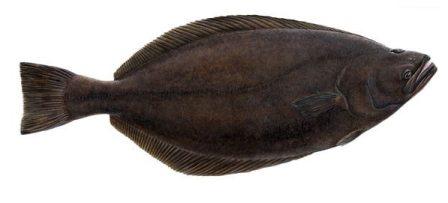Greenland halibut or Black Greenland Halibut

Greenland halibut or black halibut or Greenland halibut are an important commercial fish in the Atlantic and Arctic; this halibut is popular with culinary experts especially in East Asia. Halibut is considered a promising species for breeding and cultivation in artificial conditions. Let's take a closer look at the Greenland halibut fish.
Content
- Description of the fish Greenland halibut (black Greenland halibut)
- Types of halibut
- What kind of fish is Greenland halibut?
- What does black halibut look like?
- Halibut and flounder difference
- Where does black halibut live?
- How the black Greenland halibut swims
- What does the halibut eat?
- How does blueneck halibut spawn?
- Commercial significance of halibut
- Growing halibut in artificial conditions
Description of the fish Greenland halibut (black Greenland halibut)
Types of halibut
Typically, halibut refers to three types of fish:
Genus Hippoglossus
- Atlantic halibut, Latin name Hippoglossus hippoglossus - this halibut lives in the North Atlantic.
- Pacific halibut, Latin name Hippoglossus stenolepis - this halibut lives in the North Pacific Ocean.
Genus Reinhardtius
- Black halibut, Latin name Reinhardtius hippoglossoides, this halibut lives in the North Atlantic, throughout the Arctic and in the North Pacific.
What kind of fish is Greenland halibut?
Greenland halibut or Black Greenland Halibut (Reinhardtius hippoglossoides - Greenland halibut, Black Heilbutt). This halibut has many names, so in Canada and the USA it is known as black halibut, Greenland halibut, small halibut and Newfoundland turbot, Greenland turbot. In Europe it is better known as Greenland halibut.
What does black halibut look like?
What does black halibut look like? Black halibut reaches a length of 120 cm and a weight of up to 45 kg.
Halibut, like all halibut fish, has a flat body. During the development of the fish, the left eye shifted so that it ended up on the right side of the head. The body shape of the halibut is elongated and dorsoventrally compressed, the muscles on both sides are equally developed. Both sides of the halibut are pigmented (dark in color), but the left blind side is slightly lighter than the right.
Halibut and flounder difference
Differences between flounder and halibut? Black halibut, a flounder-like fish, but there are differences from flounder, the left eye of the halibut during the development of the fish moves so that it ends up on the right side of the head. But in halibut it does not progress as far as in flounder.
Where does black halibut live?
The question of where the black Greenland halibut lives is quite confusing. Russian sources indicate that the Greenland halibut lives in the North Atlantic and Barents Sea. In the Atlantic, it is distributed from Greenland and Novaya Zemlya to the Bay of Biscay. English-language sources indicate that black halibut lives in addition to the North Atlantic, also in the Arctic seas and the North Pacific Ocean, to Honshu and Baja California.
Bluetail halibut is an Arctic fish of the flounder family that prefers cold waters. Halibut is a deep-sea fish that lives at great depths, from 200 to 2,000 m, but mostly up to 1,000 m; in pursuit of prey, halibut rises to 100-300 m. In summer, halibut also goes to shallower depths, approaching the shores.
Black Greenland halibut is found on muddy bottoms, but often swims in the water column, making vertical migrations of considerable length, up to several hundred meters.
How the black Greenland halibut swims
How does black halibut swim? Scientists have long debated how halibut swims in the water column; many believed that it swims vertically in the water column, but as recent studies have shown, halibut swims horizontally even in the water column.
What does the halibut eat?
What does black halibut eat? Greenland halibut is a predator. What Greenland halibut eats depends on its habitat, but the main diet of halibut is fish, shrimp, amphipods, squid, and fish waste that fishing trawlers dump into the sea. So in the Beaufort Sea, halibut feeds on cod, while in the Barents Sea, halibut feeds on fish - capelin, cod, herring, blue whiting, haddock, cod, shrimp and squid.
How does blueneck halibut spawn?
Halibut reproduces in spring - early summer. Females spawn about 300 thousand large eggs, 4-4.5 mm in diameter. The hatched halibut larvae, 10-16 mm long, remain at great depths and, as they grow, move to the upper layers of water, closer to the shores. When they reach a length of 7-8 cm, they sink to the bottom.
Commercial significance of halibut
Black halibut is a commercial fish and is caught in many areas of the Atlantic.
Greenland halibut has soft and fatty light-colored meat. Halibut is one of the most expensive food fish due to its fatty, white, elastic meat. Halibut is sold in the form of slices, fresh or frozen. There are many recipes for preparing halibut.
Halibut fish grows slowly and is actively fished, which leads to the degradation of natural populations. Therefore, with Every year the issue of growing halibut in artificial conditions becomes more and more pressing.
Growing halibut in artificial conditions
Reproduction and cultivation of halibut is a complex matter and is still just developing.
Halibut is known to be grown in Scotland, Iceland and Norway. Growing halibut is capital-intensive and time-consuming, which reduces business interest in its cultivation.
In 2001, about 450 thousand units were produced in Norway and Iceland. juvenile halibut and 400 tons of commercial halibut.
Scottish company Gigha Halibut will stop farming halibut in 2023.